Bea Lines
by H.G. "Bea" Hyve
Reprinted from "Crown Jewels of the Wire", December 1996, page 10
N. R. “WOODY” WOODWARD
This will be my last “Bea Lines”, and it is with great pleasure that I am
able to finish my 11 years of writing this column by interviewing Mr. N. R.
Woodward of Houston, Texas. Having begun with the Milhollands in June 1985, it
is only fitting that I close with another pioneer in this great hobby of ours.
Mr. Woodward has done so much toward the betterment of the hobby that it
would be difficult to imagine where we would be without his contributions. He
prefers to keep a low profile, but he has very reluctantly consented to be
interviewed by “Bea Lines”, for which I shall always be grateful.
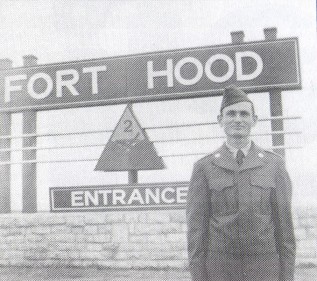
Pvt. (Rct.) Woodward
Second Armored Division Headquarters
Fort Hood, Texas
November-December 1950
N. R. “Woody” Woodward was born in National City, California, November 5,
1927. He lived in western Oregon from 1930 to 1943, during the Depression and
early war years. It was there where he first noticed insulators and began
collecting them. One of his first memories, at age 2˝ , was of a ruler lying
across the corner of the table which was used to give him periodic swats to
force him to drink goat's milk. He says, “I drank goat's milk throughout
childhood, mostly without much enthusiasm; but it's what we had!
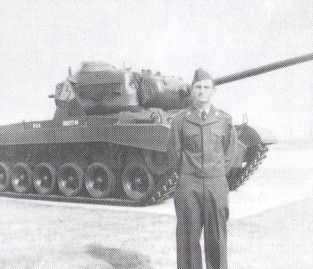
Rct. Woodward
Fort Hood, Texas
November-December 1950
“Throughout the Depression we survived by living off the land, and at age
15 I left home, working in Salem, Oregon, from 1943 to 1947. The companies for
which I worked were California Packing Corp., Salem Linen Mills, and Oregon Flax
Textiles. It was around 1943, when I was 16, that the name ‘Woody’ was given
to me. I was living behind a restaurant operated by two older sisters, Jesse and
Estella, who started calling me by that name, and it has stuck ever since.
“In 1947 I moved to Dayton, Washington, then to Hillsboro, Oregon, in 1948,
working for Southern Pacific Railroad. In 1949 I moved to Corvallis, Oregon,
still with Southern Pacific. Then came two years in the Army , from 1950 to
1952, where I was stationed at Fort Riley, Kansas, Fort Hood, Texas, Fort Sam
Houston, Texas, and Fort Bragg, North Carolina. Once out of the Army, I went to
Portland, Oregon, working for the Union Pacific Railroad, in 1953 and 1954. The
summer of 1955 found me in Salt Lake City, Utah, working for the Denver &
Rio Grande Western Railroad. I moved to Los Angeles, California, where I worked
for the Atchison Topeka & Santa Fe and the Southern Pacific Railroads, from
1956 to 1957. That same year I headed for Chicago, Illinois, and worked for the
Chicago Milwaukee St. Paul & Pacific Railroad (The Milwaukee Road) until
1959. I worked at various other jobs in Chicago following my years with the
railroad; Automatic Appliance Corp., 1960-1961 (I attended De Vry Technical
Institute in 1960 where I took a course in basic electronics while employed at
Automatic Appliance Corp.); then to Houston in November 1961 where I worked for
Washing Machine Parts Co. from 1962 to 1964. The fall of 1964 found me back in
Illinois at Oak Park, working for Home Appliance Parts. (Oak Park is physically
a part of Chicago. In fact the year I lived there, 1965, I parked the car in
Chicago, which was just across the street, since Oak Park did not allow
overnight street parking.) This is also the year of my first publication, The
Glass Insulator in America, 1865-1965 Progress Report, which came out in July of
that year. I moved back to Chicago in 1966, working for Home Appliance Parts.
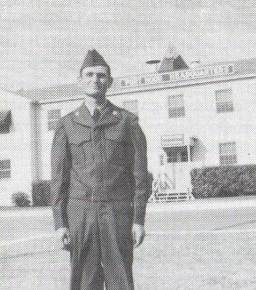
Rct. Woodward
Fort Hood, Texas
November-December 1950
“In 1967 I moved to Houston, going to work for Central Supply, where I
worked until 1975, when I went in partnership with Charles Halbert, forming
Halbert Crane & Hoist. I was there until 1978 when I went back to Central
Supply until 1982. From 1983 to 1985 I was employed by various messenger
services, but went back to Central Supply and was with them from 1986 until I
retired in 1993. Although this list in incomplete, I can sum it up this way; I
held numerous odd jobs, and work-ed for five different railroads over a period
of ten years in six different cities. Be aware that the foregoing is incomplete,
because in between the items listed there are weeks or many months of wandering,
drifting between odd jobs, visiting nearly every city and state. Often I would
be employed only two or three months out of that year, and be ‘on the road’
the rest of the time. Many of the insulators I saw were seen from the top of a
boxcar! (However, this is not the choice location. A flatcar, gondola, or empty
boxcar if the door is open on the same side as the pole line is less hazardous
and gives as good a view. On the other hand, riding the running board of a tank
car is no doubt the most hazardous, but I've done plenty of that as well.)
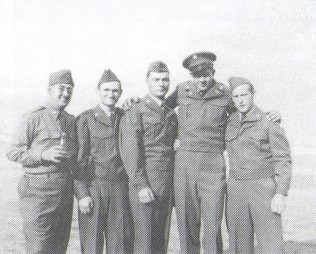
Left to right: Ferraro, Woodward, Balster, Bird, Jenkins
413th Ordnance Heavy Maintenance Company
Fort Hood, Texas
November-December 1950
“It was during those years that I collected most of the historical data on
insulators, having begun collecting seriously in 1951 while stationed at Fort
Sam Houston. Research began in earnest in 1955, and really got off the ground in
1956, with numerous hours spent in the patent files in the Los Angeles Library
(tragically destroyed by fire a few years ago); also my first visit with William
McLaughlin. Subsequently I visited every location I could identify with the
manufacture of insulators. It was from this research that the 1965 Report was
compiled. Prior to that, there was nothing. Every writer since has used the
basic data accumulated during those ten years. “My first visit with William
McLaughlin was on July 24, 1956, at a plant in Gardena which his son Don was
managing at the time. This location had just been sold to the Arrowhead &
Puritas Water Company (on February 29, 1956). William McLaughlin was retired at
the time, but was acting as advisor and would spell the workers during break. We
visited several more times, and continued to correspond through the years. I
have two fat files of letters from him, and never threw away a word he wrote.
Since at one time or another we touched on many points, I feel that my knowledge
of the McLaughlin operation is quite secure.
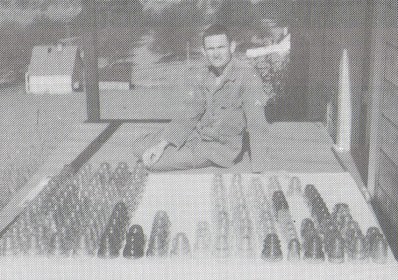
Woody with part of his early collection;
some insulators found in the area south of Portland, Oregon
May 1952
(Next photo also)
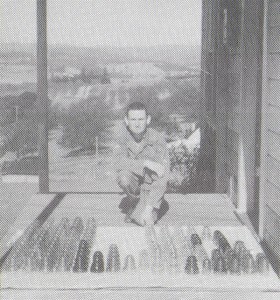
“In addition to William McLaughlin, I have also met many other old-timers
who were able to provide valuable insights into various manufacturing
operations. There was Goody Godwin, Salem, New Jersey, the last member of the
Gayner family to remember the insulator production; Charles J. McHale, Hawley,
Pennsylvania, in his 90s and describing vividly the Harloe insulator plant near
his home; John J. Macken (whom I never met but with whom I corresponded),
Muncie, Indiana, the last employee hired by Hemingray Glass Co. prior to the
Owens-Illinois purchase; William H. Loyd, Lynchburg, Virginia, retired
secretary-treasurer of Lynchburg Glass Corp., who supplied me with complete
remaining company records; I. Earl DuBois, Millville, New Jersey, son of one of
the four men who developed and built the original Whitall Tatum presses; and
William L. Brookfield, whose interest and devotion have enriched our knowledge
of insulators in every way. These are only a few of those who helped to make the
picture as complete as it is.
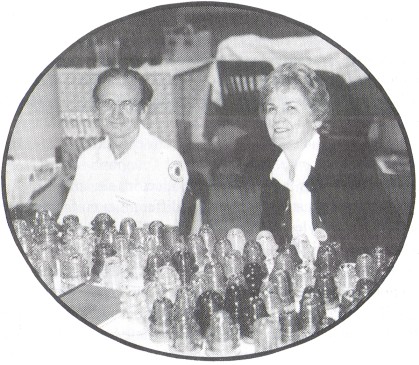
Woody and Marilyn Albers at the Austin
Bottle and Insulator Collectors Club show
Austin, Texas
October 1991
(Photo courtesy of Marilyn and Bill Albers)
“I've walked hundreds of miles of railroad tracks. Many of the insulators
which were quite common when I started collecting are now considered to be rare.
As for collecting, I have done plenty of it, to be sure. The old Postal
Telegraph line which ran from Seattle to Los Angeles was a collector's dream.
“There were insulators made by different manufacturers and also different
styles. Some examples: CD 154 McLaughlin in emerald green, light green, and
various other shades; CD 154 Whitall Tatum No. 1 in purple; CD 154 Maydwell in
straw, and Lynchburg 44; CD 145 California and Postal in SCA and purple; and CD
210 Postal in aqua; occasionally Denvers in all colors, and other goodies. In
Los Angeles, on the Los Angeles Transit Lines, I found CD 263 Hemingray Columbia
and CD 259 Oakman and Brookfields. Truckloads of these were removed and
destroyed.
“On another expedition, while on a passenger train from Chicago to St.
Paul, I noted some peacock insulators. Going back later, I found the CD 151
N.A.T. Co. in the beautiful peacock blue. Most of these were along the
Mississippi River on the border of Minnesota and Wisconsin. This railroad track
was the old Chicago, Burlington & Quincy line, presently a part of the
Burlington Northern.
“While living in Portland, Oregon, I found CD 289 Lockes, CD 283 No. 1
Provo, and V. G. Converse, all in aqua, on Portland General Electric Lines (one
of the two utilities serving the area; the other is Pacific Power & Light) .
One PGE line where these were in service ran between Golf Jct. and Milwaukie along the Portland Traction Co. interurban rail line. That is (or was) one of
hundreds of lines belonging to Portland General Electric. Portland is, so far as
I know, unique in having two competing power companies dividing the territory.
The CD 289 Locke was known by local linemen as 'Portland Glass'. They do appear
as No. 26 in one Locke catalog only (1906); but since they were so numerous in
and around Portland, I always wondered if that particular insulator could have
been designed by, and made for, an electrical engineer in the Portland area.
I've not seen that one elsewhere.
“In Cincinnati the CD 269 Oakman Mfg. Co. Jumbo in aqua and light blue were
abundant on steel poles that once carried feeder cables for street railways. I
either obtained power insulators from linemen as they removed them, or, more
often, from the salvage yard or shop where the material was brought in by the
line crews. Some communication insulators, of course, were removed from the
lines.
“The CD 214 in green were numerous around Houston, and Texas. Southern
Pacific had several spots where they were concentrated; and on the MKT (the Katy
RR) there were several hundred of them between Houston and Sealy. I recall one
late summer night atop a pole between Katy and Brookshire, around 1970,
replacing several of those. My partner on the ground suddenly said, ‘Look out,
there's an owl.’ I glanced upward, and this huge owl was hovering above me,
its wings slowly flapping. I imagine he (or she) was thinking, ‘I've been
sitting on this pole for 40 years and never saw anything like this up here
before.’ Anyway, it slowly soared away a few seconds later, deciding against
an attack.
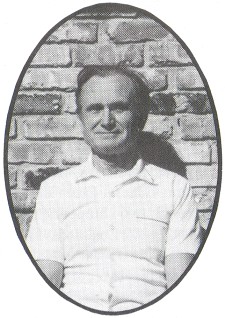
Woody outside of his apartment
Houston, Texas
Early 1993
“In the 1980s I made two trips to England (1981 and 1988). I spent about
ten days each time, courtesy of a fellow Mensa member in Derby with whom I had
been corresponding. We traveled, both driving and by rail, over much of the
Midlands and Wales. Since all of the insulators in Britain are porcelain, they
do not come directly in line with my primary field of research. However, I did
visit the Doulton factory in the Midlands around Stoke-on-Trent. The area is
called ‘The Potteries’ locally, and there are centuries-old plants still in
operation. At the Doulton factory we watched them making porcelain insulators,
many for export to various places, so they were not necessarily British styles.
(Most lines in Britain are underground except for the very high voltage
transmission lines.) I did sneak onto a railway property (not an easy thing in
Britain), and climbed a few poles for red porcelain marker insulators from
abandoned signal circuits. Scotland Yard did not become aware of the fact!
Trespassing on railway property in Britain is in itself a felony, except, of
course, at stations and train platforms.”
As most insulator collectors know, Woody gave us the Consolidated Design (CD)
numbers for glass insulator identification. The idea was born probably in 1951.
Woody says, “In October of 1952 I went from active duty to inactive Army
Reserve status; and it was after that that insulator collecting really got off
the ground. At the outset I developed a CD system that I used for a year or so,
but it didn't suit, so I scrapped it and started the system we use today. Since
no one else was in any way involved in all this until almost 15 years later, I
have no records and no exact time frame, but I suspect the system we use today
was finalized in 1953 or 1954.”
Every different threaded glass pintype insulator style found so far has been
assigned its own CD number by Woody, and he is the only person with the
authority to issue new numbers. He states, “The reason for the CD numbers is
the need for approximate identification of insulator styles regardless of their
markings. Although a majority of insulators carry a manufacturer's style number,
many do not, and therefore carry no key to their style. It is also true that the
same style insulator may have several different numbers, assigned by different
manufacturers at different times. It is also true that one manufacturer
sometimes uses the same style number for totally different insulator types at
different times.
“I used the word ‘consolidated’ because one number is provided to cover
one style, which may have several different manufacturer numbers, as previously
stated. For example, CD 162 has been sold as Number 2, 4, 19, 36, 36-190, and
1678 at different times and by different manufacturers. My CD number
consolidates that style into a single number (162). Thus it is seen that there
is a definite need for a consolidated numbering system for identifying purposes.
“Public use of the CD numbers was first initiated by someone other than me
in November of 1965, when early collector Helmer Turner asked for and received a
list of the numbers for use in his personal collection. It was later through his
efforts that the CD numbers began to come into general use. They first appeared
in my 1967 Report.”
Woody's literary contributions to the hobby are many. He has authored five
books and coauthored two others. His first one was The Glass Insulator in
America, 1865-1965 Progress Report, which was soon followed by The Glass
Insulator in America, 1967 Report, 1969 Report, 1973 Report, and 1988
Report.
Woody says that each subsequent Report is an update of the original material
which is duplicated except where it is altered or expanded. So unless one wants
them simply as collectors' pieces, it is not necessary to try and obtain the
earlier Reports. (However, the 1988 Report should be a part of every insulator
collector's library.)
These books contain scale drawings of the CD numbers, and each Report
reflects hours of research, and is beautifully done. Woody states that, “The
1965 Report did not have drawings, just text. In the latest Report, ALL of the
drawings should be attributed to Jack Tod. Although he used some earlier ones,
they were all retouched by him so as to be uniform.
Glass Insulators from Outside North America was coauthored by Woody and
Marilyn Albers in 1986, with the Second Revision published in 1993. This book is
the definitive source of information on foreign glass insulators, and also
contains scale drawings along with CD numbers. These two books are also “must
haves” for the insulator collector.
For over 26 years, Woody has volunteered to answer questions related to
insulators through the pages of Crown Jewels of the Wire, with his first column,
“Questions Answered”, appearing in November 1969. At times he also answered
questions in a column called “Research Division”. In December 1986 his
column was renamed “Ask Woody”. Through these columns Woody has answered
hundreds of collectors’ questions, sharing his vast storehouse of knowledge
with others. It also would be well to mention that writers, researchers, and
historians of insulator data can always rely on a helping hand from Woody.
Unlike some knowledgeable persons, he is extremely generous with his knowledge,
and always sends prompt replies filled with accurate, precise, abundant
information. He is a walking encyclopedia of insulator data, and willingly
dispenses it to anyone who writes for help. (But even though he has aided so
many of us with his knowledge, he doesn't realize or acknowledge just how much
he means to us and to our hobby!)
In addition to the question-and-answer columns, Woody has written at least
eight articles for Crown Jewels of the Wire, which include several obituaries,
articles on insulator colors, and the use and explanation of CD numbers, among
other subjects. And, in 1992 the Lone Star Insulator Club of Houston initiated
the annual N. R. Woodward Literary Award. This award honors one writer each year
for the published article that best demonstrates research or promotion of the
insulator hobby. This tribute to Woody will encourage further insulator
research, and is given each year at the banquet at the NIA national convention.
The first award was presented June 20, 1992, in Orlando, Florida.
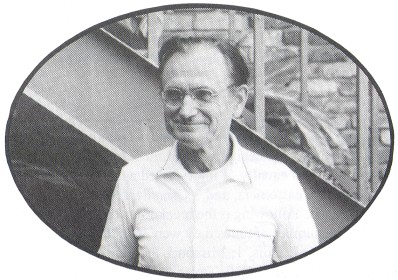
N.R. "Woody" Woodward
(Photo courtesy of Marilyn and Bill Albers)
In conclusion, I'd like to say that I truly appreciate Woody's participation
in “Bea Lines”, because I know that he really didn't want to do it, and it
was difficult for him. But, being such an important part of our hobby as he is,
I wanted so badly to end my career as a writer of collector profiles with him.
Because of his knowledge, intelligence, sense of humor, and humility, it is a
joy to correspond and talk with him. Woody, for your many contributions to our
hobby, for your friendship and help over the years, and for this “Bea Lines”,
I thank you so much.
|
